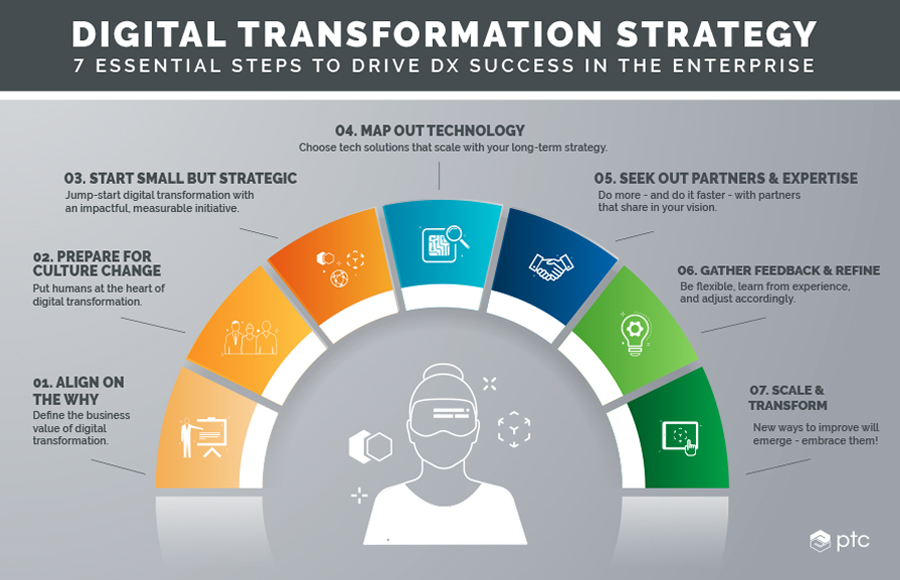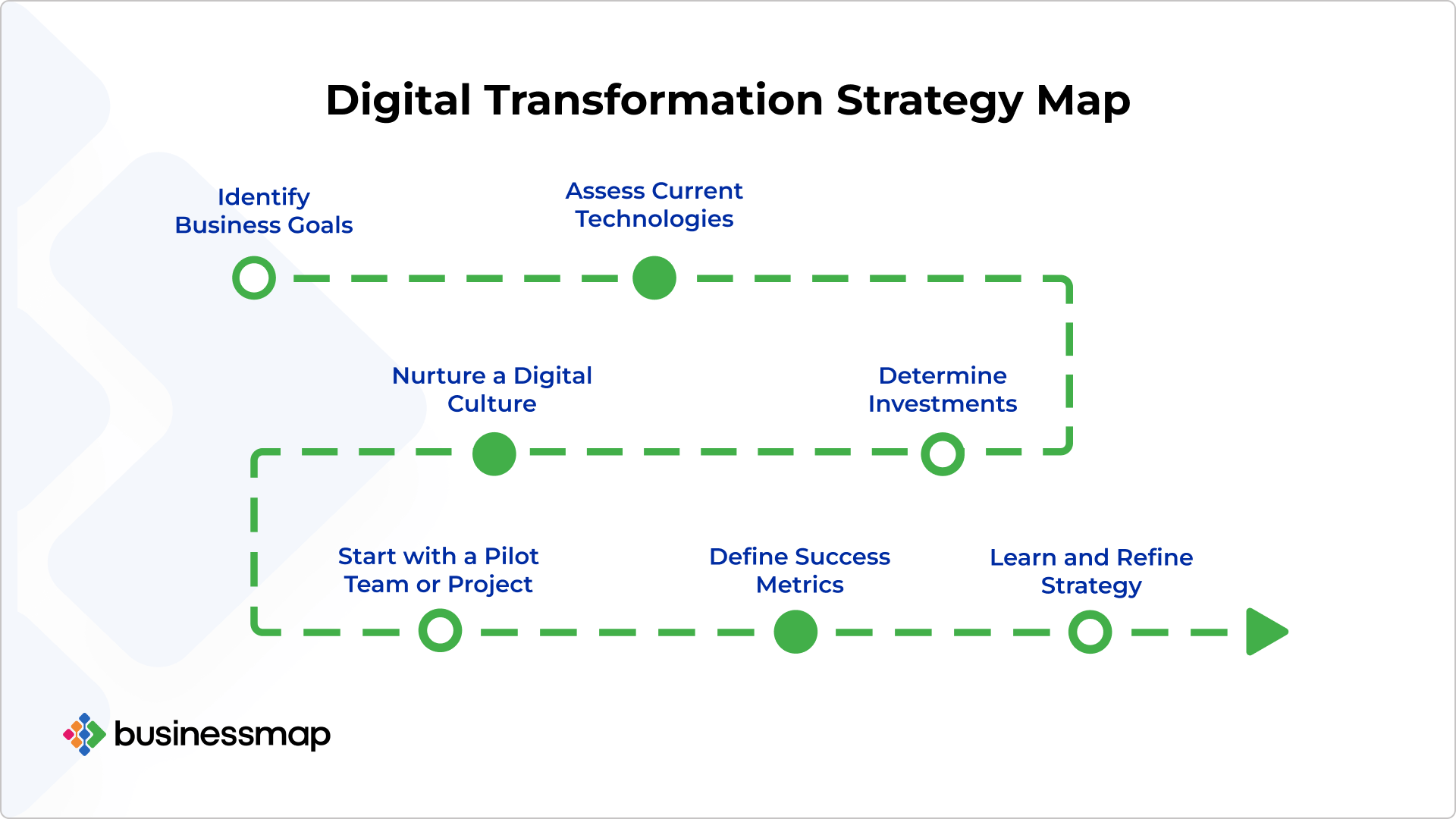Digital Transformation Strategies: A Comprehensive Guide
In today’s fast-paced digital world, businesses need to continuously evolve to stay ahead of the competition. Digital transformation is no longer a choice but a necessity for companies aiming to remain relevant. Whether it’s enhancing customer experiences, streamlining internal operations, or driving innovation, digital transformation strategies can help businesses meet these goals. In this article, we’ll explore digital transformation strategies that can help organizations unlock their full potential and thrive in the digital age.

What is Digital Transformation?
Digital transformation refers to the process of integrating digital technologies into every aspect of a business. It is a fundamental change in how businesses operate and deliver value to customers. A well-executed digital transformation strategy enables businesses to leverage technology to innovate, improve operational efficiency, and enhance the customer experience.
Key Areas of Digital Transformation:
- Customer Experience: Utilizing technology to create personalized and seamless experiences across various touchpoints.
- Business Processes: Automating and optimizing processes to improve efficiency and reduce costs.
- Data and Analytics: Leveraging data to gain insights and make data-driven decisions.
- Business Models: Redefining business models to adapt to digital trends, such as subscription-based services or digital platforms.
Importance of Digital Transformation Strategies
Having a solid digital transformation strategy is crucial for any organization looking to succeed in the modern business landscape. Here are a few reasons why digital transformation strategies are essential:
- Staying Competitive: As more businesses embrace digital tools, companies that don’t keep up will fall behind.
- Boosting Efficiency: Automation and digital tools help businesses streamline their processes, leading to increased productivity.
- Enhancing Customer Satisfaction: Customers today expect personalized, real-time interactions. Digital transformation helps businesses meet these expectations.
Core Benefits of Digital Transformation:
- Increased agility in responding to market changes.
- Cost reductions through process automation and optimization.
- Improved collaboration between teams using digital platforms.
- Data-driven decision-making for more effective strategies.
Key Digital Transformation Strategies for Success
1. Adopt a Customer-Centric Approach
A customer-centric approach is at the heart of any successful digital transformation strategy. This involves utilizing digital technologies to create personalized experiences for customers. Businesses should focus on understanding customer needs and preferences by collecting and analyzing data from various touchpoints.
How to Implement a Customer-Centric Strategy:
- Utilize CRM systems to manage customer relationships and track interactions.
- Leverage analytics tools to analyze customer data and gain insights into behavior and preferences.
- Personalize customer journeys by delivering tailored content, offers, and experiences across multiple channels.
Example:
Many companies, like Amazon, have successfully implemented customer-centric strategies by utilizing sophisticated algorithms to recommend products based on individual customer preferences.

2. Embrace Cloud Computing
Cloud computing is one of the cornerstones of digital transformation. It provides businesses with the flexibility, scalability, and cost-efficiency they need to innovate and scale their operations. With the cloud, businesses can access data and applications from anywhere, at any time, which is especially important in today’s remote working environment.
Benefits of Cloud Computing:
- Scalability: Easily scale infrastructure to meet growing business needs without large upfront investments.
- Collaboration: Employees can collaborate in real time, regardless of location.
- Cost Efficiency: Reduce capital expenditures on hardware and software by leveraging cloud services.
3. Integrate Data and Analytics
Data is the driving force behind digital transformation. By collecting, analyzing, and using data, businesses can make informed decisions, improve efficiency, and enhance customer experiences. Implementing a strong data strategy is key to digital success.
How to Integrate Data and Analytics:
- Implement data analytics tools to analyze customer behavior, operational performance, and market trends.
- Use AI and machine learning to predict future trends, automate processes, and optimize decision-making.
- Centralize data in a unified platform to enable easy access and collaboration across departments.
Example:
Netflix uses data analytics to track user behavior and make content recommendations, which has contributed significantly to its success.
4. Automate Business Processes
Process automation is another critical element of digital transformation. By automating repetitive tasks and workflows, businesses can improve efficiency, reduce costs, and allow employees to focus on more strategic initiatives.
Key Areas for Process Automation:
- Customer service: Use chatbots or automated help desks to assist customers 24/7.
- Marketing: Implement automated email marketing campaigns and personalized outreach.
- HR and payroll: Automate employee onboarding, time tracking, and payroll processes.
5. Foster a Culture of Innovation
A successful digital transformation strategy isn’t just about technology; it’s also about fostering a culture of innovation within the organization. Encourage employees to embrace new technologies, experiment with creative solutions, and constantly look for ways to improve.
How to Foster Innovation:
- Promote continuous learning by providing employees with access to online courses and workshops.
- Create an innovation-friendly environment by supporting experimentation and collaboration across departments.
- Invest in R&D to explore new technologies and products that can drive growth.
6. Leverage Artificial Intelligence (AI) and Machine Learning (ML)
AI and ML are revolutionizing business operations by providing companies with tools to automate processes, predict future trends, and gain insights from data. These technologies play a crucial role in improving decision-making, personalizing customer experiences, and optimizing operations.
Implementing AI and ML:
- Chatbots and virtual assistants: Automate customer support with AI-driven chatbots.
- Predictive analytics: Use machine learning to forecast demand, customer behavior, and market trends.
- AI-driven marketing: Personalize marketing campaigns using AI to deliver the right message to the right audience at the right time.
7. Adopt Agile Methodologies
An agile approach enables businesses to respond quickly to changing market conditions and customer demands. By adopting agile methodologies, companies can continuously improve their digital transformation efforts and adapt to new challenges.
Benefits of Agile Methodologies:
- Faster product development: Develop and release products in shorter cycles.
- Improved collaboration: Foster better communication and collaboration between teams.
- Customer-centric focus: Focus on delivering value to customers in iterative phases.
Challenges in Implementing Digital Transformation Strategies
While digital transformation offers numerous benefits, it’s not without its challenges. Some of the common hurdles businesses face include:
- Resistance to change: Employees may be resistant to adopting new technologies or changing traditional processes.
- Data security: With more data being collected and stored, ensuring robust cybersecurity is essential.
- Cost and complexity: Implementing digital tools and technologies can be expensive and complex, especially for smaller businesses.
Overcoming Challenges:
- Change management: Invest in training and support to help employees embrace new technologies.
- Data protection: Implement strong security measures and compliance protocols.
- Start small: Begin with smaller, manageable projects to gradually build confidence and gain momentum.
Conclusion
Digital transformation is not just about adopting new technologies; it’s about fundamentally changing the way businesses operate and interact with customers. A well-crafted digital transformation strategy can help businesses stay competitive, improve operational efficiency, and foster innovation. By focusing on areas such as customer experience, cloud computing, data analytics, and automation, companies can navigate the complexities of digital transformation and position themselves for long-term success.
FAQs about Digital Transformation Strategies
1. What is the first step in creating a digital transformation strategy?
The first step is to assess your current processes, identify areas for improvement, and set clear goals for your digital transformation.
2. How long does it take to implement a digital transformation strategy?
The timeline varies depending on the complexity of the transformation, but most businesses can expect it to take several months to a few years.
3. Do small businesses benefit from digital transformation?
Yes, digital transformation can help small businesses streamline operations, improve customer engagement, and stay competitive in their industry.
4. What are the costs associated with digital transformation?
Costs can vary widely based on the scope of transformation. However, many digital tools and technologies offer scalable pricing, allowing businesses to start small and expand as needed.
By developing a strategic approach and implementing the right technologies, businesses can reap the benefits of digital transformation and secure a successful future in the digital age.

